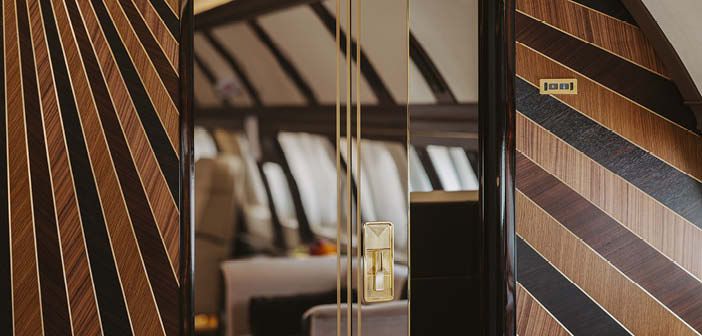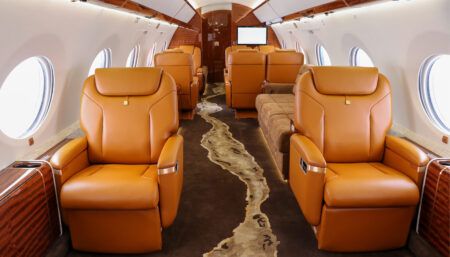To support the aircraft’s range potential, Jet Aviation Basel had to minimise cabin weight on a recent ACJ319neo completion project, while also creating a finely detailed and quiet Art Deco interior.
It’s not often that Jet Aviation can share its bespoke work publicly, but with charter use on the cards for the ACJ319neo it recently completed, the wraps are off. The aircraft arrived at the company’s facility in Basel, Switzerland, in July 2022, and was redelivered in March 2023, “quite a bit ahead of schedule”, shares Hendrik Janssen, head of completion sales at Jet Aviation.
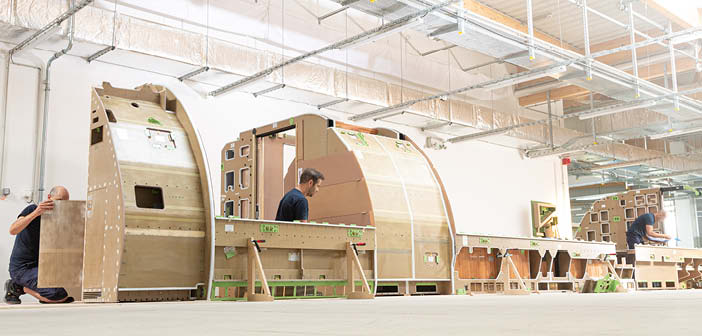
The Europe-based customer specified a contemporary Art Deco interior suitable for work and leisure. It was created by the Jet Aviation Design Studio working with the customer and their interior architect, Colin Radcliffe.
The configuration includes a welcome area with customised flight attendant seats, galley and VIP lavatory. A key feature of the area is the custom real wood floor made from light smoked oak with resin inlays, inspired by Riva boats. “That was a joint effort with one of our suppliers,” says Janssen. “The client mentioned that he liked boat decks, then our designer was quickly able to provide a sample.”
The first part of the main cabin is a dining area with a club-two arrangement intended for multiple uses. The dining table is enhanced by intricate brass inlays.
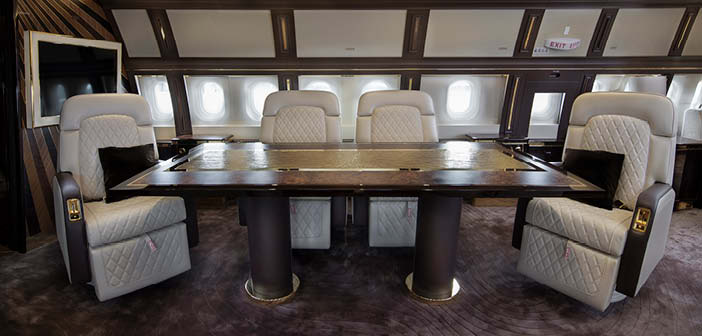
Then follows the lounge with an L-shaped divan set opposite another sofa rather than a screen, which Janssen says would be more traditional. “It allows for a lot of communal get-togethers, having a drink, discussions,” says Janssen. “This aircraft doesn’t have a big monitor to enable a cinema setting, because the customer looked at what they did on the charter jets they used. Everybody was bringing personal devices on board. They want this aircraft to be for gatherings of family or friends.”
Be my guest
This is also accommodated in the next section, which can serve as an enclosed office or guest room where two people can sleep. It has a wardrobe and is decorated with embroidered wall finishings. “You can close two sliding doors so it’s a private space for a couple or the kids for instance,” explains Janssen. “Or, going with the concept of community, once you open up the doors, you have a club two on the opposite side, and four people can sit and share a drink in what could be like a private lounge.”
Then there is an aft master suite with a luxurious en-suite master bathroom that is finished in both beige onyx and a gold and black limestone called Nero Portoro. These materials harmonise with the cabin’s other design choices, which include dark woods and tiling; open-pore walnut veneer; a custom-dyed ombré carpet; antique-look silver mirrors; light beige 100% Mohair upholstery; and, in the office, dark brown velvet with gold embroidery.
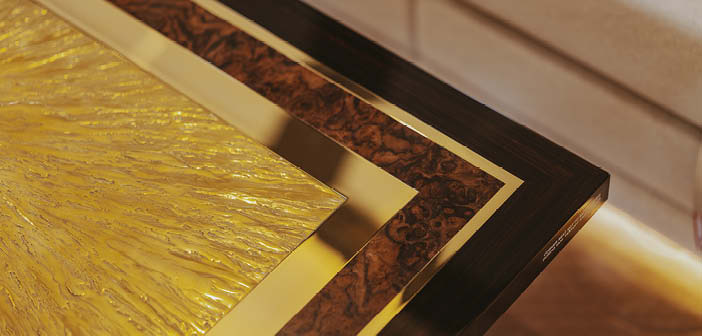
Here comes the sun
Perhaps the most eye-catching part of the design is the sunburst marquetry, which spreads across an entire bulkhead in the main cabin. Handcrafted on-site, the marquetry is composed of more than 180 rays made from four veneers – two light and two dark – interspersed with brass inlays that are 3mm (0.1in) wide. Janssen shares that the client’s original reference point for the design was a wall covering in a London restaurant.
Christoph Fondalinski, vice president of completions at Jet Aviation, praises the expertise that went into creating the sunburst, particularly as the inlays become very thin at the top. “We produced mock-ups throughout the process to make sure it would work, but in the end you need to do the final art piece, making sure that it is very set and cannot break,” he says. “That’s where the capability in our production centre is critical.”
“Managing a CNC machine is something many can do, but making sure the finishing is good, that the surface is flush, that’s where our experience comes into play,” Fondalinski continues. “We’ve been doing completions for more than 45 years and we have the capability to produce it all in-house – from design through engineering, production and installation.”
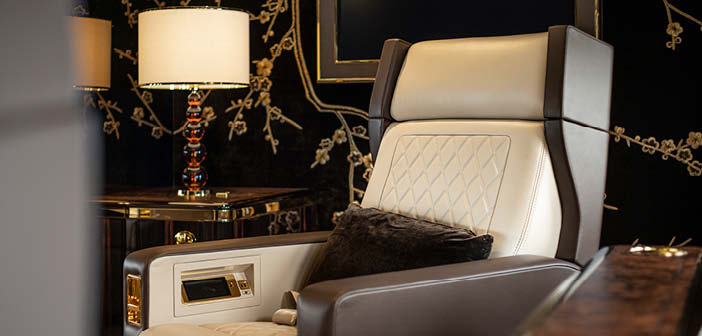
As well as ‘wingback’ seating, Jet Aviation created a special custom seat for the principal. “In one of the first meetings, the principal showed us images of his house and all kinds of things he likes, including a 1920s Art Deco seat,” explains Janssen. “We were able to translate that inspiration. The seating area is covered in a mohair that the principal owned. The outside of the seat is covered in a Macassar ebony. It has almost a floating shape around the armrests; you can imagine that laying such a veneer is very complicated to do.”
Janssen adds that it’s normal for Jet Aviation to customise seats to suit a principal’s build. “We enable the customer to try everything prior to final production,” he says. “Even though the seat cushions are designed to save weight, we have different foam densities we can use.”
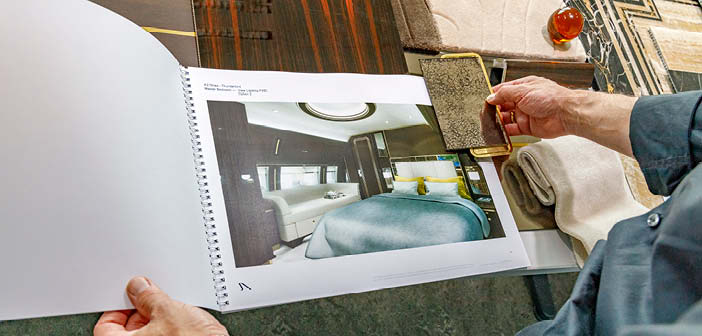
Weight and sound
Weight saving was particularly important to make the most of the narrow-body airframe’s potential range. “We delivered a similar interior two years before this one, and the improvement on weight, even though we put more complex elements into the cabin, like a stone-floored shower, is significant,” comments Janssen. “We continuously do research and development through our Innovation Committee. Every little idea, every kilogram counts on an aircraft.”
The company continues to target weight reduction in parallel with progressively quieter cabins. “We were, again, under the contractual weight with this delivery, but at the same time it’s quieter than we committed to,” says Fondalinski. “It’s a very quiet interior, which is very important for the comfort of the principal and his guests.”
Fondalinski shares that the company benefits in these areas from its close relationship with General Dynamics sister company Gulfstream. “We work with our colleagues at Gulfstream and once we have a layout defined, we use computer analysis to determine potential areas of noise for that airframe type and layout,” he explains. “These areas are to be treated specifically. Then it’s also about the way we build up the cabin. If you have certain areas that are not properly closed out, the whole concept fails. Choosing the right materials, knowing where to apply them, and the quality of installation are all critical.”
This feature was first published in the July 2023 edition of Business Jet Interiors International.


